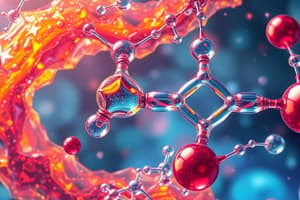Podcast
Questions and Answers
Which of the following statements accurately describes alkenes?
Which of the following statements accurately describes alkenes?
- They contain one or more double bonds between carbon atoms. (correct)
- They are cyclic hydrocarbons.
- They contain only single bonds between carbon atoms.
- They contain only carbon and hydrogen atoms arranged in a ring.
The main carbon chain in an alkene must always be the longest possible chain, regardless of the location of the double bond.
The main carbon chain in an alkene must always be the longest possible chain, regardless of the location of the double bond.
False (B)
What is the general formula for an alkene?
What is the general formula for an alkene?
- $C_nH_{n}$
- $C_nH_{2n+2}$
- $C_nH_{2n}$ (correct)
- $C_nH_{2n-2}$
Hydrocarbons with at least one double bond are classified as being ________ hydrocarbons.
Hydrocarbons with at least one double bond are classified as being ________ hydrocarbons.
Which suffix is used in the IUPAC name of alkenes?
Which suffix is used in the IUPAC name of alkenes?
Which of the following is true about alkynes?
Which of the following is true about alkynes?
The naming of alkynes follows a different set of rules than the naming of alkenes.
The naming of alkynes follows a different set of rules than the naming of alkenes.
The suffix used to denote alkynes in IUPAC nomenclature is ________.
The suffix used to denote alkynes in IUPAC nomenclature is ________.
What term describes molecules with the same chemical formula but different arrangements of atoms?
What term describes molecules with the same chemical formula but different arrangements of atoms?
Which type of isomer differs in the arrangement of atoms but belongs to the same hydrocarbon family?
Which type of isomer differs in the arrangement of atoms but belongs to the same hydrocarbon family?
Functional isomers have the same type of functional group but differ in the arrangement of the carbon skeleton.
Functional isomers have the same type of functional group but differ in the arrangement of the carbon skeleton.
Which of the following is an example of a functional group that could differentiate functional isomers?
Which of the following is an example of a functional group that could differentiate functional isomers?
What condition must be present for geometric isomerism to occur in alkenes?
What condition must be present for geometric isomerism to occur in alkenes?
In geometric isomers, what is the difference between a cis isomer and a trans isomer?
In geometric isomers, what is the difference between a cis isomer and a trans isomer?
Match the following terms with their descriptions:
Match the following terms with their descriptions:
Alkanes have an '-ene' ending.
Alkanes have an '-ene' ending.
Which of the following best explains why geometric isomerism does not generally occur in alkanes?
Which of the following best explains why geometric isomerism does not generally occur in alkanes?
In naming alkenes, it is important to locate the number that indicates the location of the ________ bond.
In naming alkenes, it is important to locate the number that indicates the location of the ________ bond.
Give the IUPAC name for the simplest alkyne.
Give the IUPAC name for the simplest alkyne.
Flashcards
Alkenes
Alkenes
Hydrocarbons with one or more double bonds, forming continuous chain and branched-chain structures.
Naming Alkenes
Naming Alkenes
Alkenes are named following the format of alkanes but with an '-ene' suffix identifying the presence of a double bond.
Alkene General Formula
Alkene General Formula
Alkene formula where 'n' is the number of carbon atoms. Indicates fewer hydrogen atoms due to double bonds.
Alkynes
Alkynes
Signup and view all the flashcards
Naming Alkynes
Naming Alkynes
Signup and view all the flashcards
Alkyne General Formula
Alkyne General Formula
Signup and view all the flashcards
Isomers
Isomers
Signup and view all the flashcards
Structural Isomers
Structural Isomers
Signup and view all the flashcards
Functional Isomers
Functional Isomers
Signup and view all the flashcards
Geometric Isomers
Geometric Isomers
Signup and view all the flashcards
Study Notes
Alkenes
- Alkenes are hydrocarbons containing one or more double bonds
- Similar to alkanes, alkenes can form continuous chain and branched-chain structures
Naming Alkenes
- Alkenes have an "-ene" ending
- Names follow the same format as alkanes: prefix + root + suffix
- The main chain must contain the double bond, even if it's not the longest chain
- Use a number to locate the double bond
- General formula is CnH2n
Example Alkene
- 2-ethyl-1-butene
Properties of Alkenes
- Alkenes have at least two carbon atoms
- Alkene compounds have fewer than four bonded atoms
- Alkenes are unsaturated hydrocarbons
Drawing Alkenes
- Example alkene: 4-methyl-2-pentene
Alkynes
- Alkynes are aliphatic compounds containing one or more triple bonds
- Alkynes are unsaturated hydrocarbons
Naming and Drawing Alkynes
- Follow the same general rules as alkenes
- The suffix is "-yne" to denote a triple bond
- General formula is CnH2n-2
Example Alkyne
- 3-ethyl-5-methyl-1-heptyne
Isomers
- Isomers are molecules with the same chemical formula but different structures
Structural Isomers
- Structural isomers differ in the arrangement of atoms
- Structural isomers belong to the same hydrocarbon family
- Example: 2-methylpentane and 3-methylpentane
Functional Isomers
- Functional isomers differ in the type of functional group
- The different molecules belong to different hydrocarbon families
- Examples: Hydroxyl (OH) and amine (NH4)
Geometric Isomers
- Geometric isomers differ in the position of groups attached to either side of a carbon-carbon double bond
- Cis isomers have both groups on the same side
- Trans isomers have the groups on opposite sides
- Geometric isomerism occurs because double bonds are rigid and cannot rotate like single bonds
Cis-Trans Isomers Examples
- Cis-2-butene
- Trans-2-butene
Studying That Suits You
Use AI to generate personalized quizzes and flashcards to suit your learning preferences.



